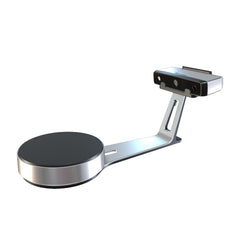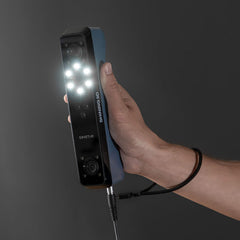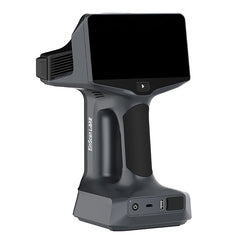Imagine being able to create a digital model of every object that surrounds you. This may have sounded like science fiction a few decades ago, but today it's reality.
3D scanning is a modern-day marvel that is becoming more accessible and affordable by the day. However, they are still a big investment and most buyers want to be 100% sure they are worth the money.
Today we will investigate the accuracy of consumer-grade 3D scanners, what physical objects they are able to scan, and some tips on how to choose the best 3D scanner for your needs. We will also explore how they can be used in education and introduce three popular models that are worth checking out!
How do 3D scanners work?
3D scanners operate based on various technologies, but the most common ones are laser triangulation and structured light.
In laser triangulation, the scanner projects a laser line or dot onto the object, and a sensor calculates the distance to the surface based on the angle of the incoming reflection. Structured light scanners, on the other hand, project patterns of light onto the object and use cameras to record the deformation of the pattern caused by the object's shape.
Both methods result in a "point cloud" – a large set of data points in three-dimensional coordinates that represent the object's surface. This raw data is then processed and converted into a mesh model made up of tiny triangles, creating a digital 3D representation of the scanned object.
How accurate are 3D scanners?
The accuracy of 3D scanners can vary significantly based on the technology used, the quality of the device, and the conditions of the scanning environment.
High-end professional scanners often boast impressive accuracy, capable of capturing details down to a few tens of micrometres - about the width of a human hair. However, more affordable consumer-grade 3D scanners typically offer an accuracy ranging from 0.1mm to a few millimetres.
It's important to note that all scanners have limitations and potential sources of error. Factors such as the object's material, colour, and surface finish, as well as environmental conditions like lighting and temperature, can all impact the accuracy of the scan.
Here are some items your average consumer-grade 3D scanner is capable of accurately scanning:
- Personal items: objects like jewellery, footwear, glasses, or toys can easily be scanned to create 3D models for design purposes or replication via 3D printing
- Art and sculpture: artists and art enthusiasts can scan sculptures, pottery, or other pieces of art to create digital portfolios, study the works in detail, or even create replicas.
- Components and parts: DIY enthusiasts and makers often scan parts for reverse engineering, customization, or to create replacement parts using 3D printing.
- Organic materials: plants, rocks, and even small animals can be scanned for study or for use in digital art or video game design.
Benefits of using 3D scanners in the classroom
Incorporating 3D scanners into the classroom opens up a world of interactive, hands-on learning opportunities that can enrich the educational experience across a range of subjects.
For STEM fields, 3D scanning offers an engaging way to introduce concepts related to geometry, engineering, physics, and computer science. Students can scan objects and manipulate the resulting 3D models to their liking. Additionally, 3D scanning can be used in conjunction with 3D printing for a range of interdisciplinary projects, allowing students to create physical replicas of scanned objects.
By integrating real-world technology into the learning process, 3D scanners prepare students for future careers in fields like engineering, computer science, design, and more.
Tips for choosing the right 3D scanner
Choosing the best 3D scanner for a classroom setting involves considering the educational objectives, the students' age and skill level, and the budget. Here are some tips to help you make the right choice:
Ease of Use: classroom scanners should be user-friendly with intuitive software interfaces. This allows students to focus more on learning the concepts and less on struggling with complicated technical procedures. Look for models that offer automatic calibration and easy setup.
Accuracy and Resolution: depending on the educational purpose, you might need a scanner that can capture high levels of detail. However, for many classroom projects, ultra-high precision might not be necessary. Balance accuracy needs with cost.
Speed: in a classroom setting, you might have multiple students needing to use the scanner within a limited period. Therefore, a scanner that can capture objects quickly might be beneficial.
Budget: classrooms often operate under budget constraints. Fortunately, there are many affordable 3D scanners on the market that offer a good balance of cost and performance.
Software Compatibility: ensure the scanner's output is compatible with the software you're using in the classroom, whether that's for 3D modelling, CAD design, or 3D printing.
Portability: a portable scanner can be an advantage in a classroom setting, allowing you to easily move the scanner between different spaces or groups of students.
Best entry level 3D scanners on the market
Magic Swift PLUS
Cost: $1,199.00 inc GST
The Magic Swift PLUS leads the consumer market as the first 3D scanner capable of wide-format scanning. It boasts easy operation, high efficiency, and an accuracy of up to 0.1 mm, capable of capturing intricate details. In addition, each scanner is factory calibrated, allowing for easy set up and use.
The scanner is compatible with both Windows 10/11 and MacOS 11/12, making scanning a breeze and offering a gateway to the advancements in 3D technology for new users. The 3D models produced can be directly manipulated in design software, such as UnrealEngine, Autodesk Maya, TinkerCAD, 3Ds Max, Cinema4D, Mudbox, and more.
Thanks to Magic Swift PLUS' NIR Spectroscopy, it projects a pattern onto the object's surface, invisible to the human eye, allowing easy scanning in sunlight. It uniquely incorporates a multi-spectral optical projection device, preventing visible light from disrupting the scanning results.
Finally, this 3D scanner offers two modes of scanning. The turntable mode provides an automatic scanning process for a convenient user experience, while the handheld mode offers flexibility and ease of operation. Additionally, for outdoor scanning needs, the scanner is compatible with a portable power bank.
EinScan SE
Cost: $1,562.00 inc GST
The EinScan SE is a structured light scanner, known for its relatively high resolution and accuracy for its price range. It offers two scanning modes: auto scan and fixed scan, which allows for flexibility depending on the size and complexity of the object being scanned. The scanner is capable of capturing objects with an accuracy of up to 0.1 mm, which is suitable for classroom applications.
One of the standout features of the EinScan SE is its ease of use. Its software is user-friendly and intuitive, making it a good choice for beginners. The automatic calibration feature is a time saver and ensures consistent results.
The EinScan scanner includes a turntable, simplifying the process of capturing full 360-degree scans of small to medium-sized objects. For larger objects, the scanner can be removed from the stand and used in handheld mode, though this may slightly decrease accuracy.
One potential downside is that the EinScan SE does not capture colour information. If you need to create full-colour 3D models, you might need to consider a different model or use additional software and hardware.
EinStar 3D Scanner
Cost: $1,595.00 inc GST
The EinStar is a handheld 3D scanner targeted at beginners, promising ease of use and the ability to generate detailed, textured 3D models.
This device is handheld, meaning it doesn't come with a turntable or tripod. Although using a turntable can be beneficial for scanning smaller objects with the EinStar, it's not a necessity for most scanning tasks. This handheld 3D scanner is known for its ability to gather dense point cloud data, with a remarkable point distance of up to 0.1 mm.
The EinStar 3D scanner operates with its unique Exstar software which introduces several unique features not seen before in the brand's scanner software. Most noteworthy among these is the Data Quality Indicator, a setting you can enable during 3D scanning. This innovative feature provides a colour-graded display of the current scan, with green signifying sufficient detail capture, while yellow and red indicate areas that require additional data collection.
Find 3D scanners for the Australian classroom
At CD-Soft we supply the latest 3D scanning technology to secondary and tertiary institutions, as well as DIY enthusiasts. Find handheld 3D scanners or turntable ones, including those listed above.
Create digital 3D models for virtual reality or print them out using one of our 3D printers. Browse our range today and start replicating real-world objects in your classroom or at home!
Contact us today for any questions regarding our 3D scanner or 3D printers in Australia. One of our dedicated team members will be happy to assist you!



 EinScan SE V2 3D Scanner - $1,967.90 inc GST
EinScan SE V2 3D Scanner - $1,967.90 inc GST EinScan SP V2 3D Scanner - $3,399.00 inc GST
EinScan SP V2 3D Scanner - $3,399.00 inc GST EinStar Handheld 3D Scanner - $1,595.00 inc GST
EinStar Handheld 3D Scanner - $1,595.00 inc GST EinStar VEGA Handheld 3D Scanner - $3,289.00 inc GST
EinStar VEGA Handheld 3D Scanner - $3,289.00 inc GST EinScan Libre Handheld 3D Scanner - $42,999.00 inc GST
EinScan Libre Handheld 3D Scanner - $42,999.00 inc GST






